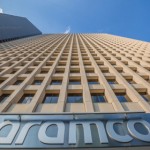Within two days of listing, Saudi Aramco’s stock price rose to 38 riyals ($10.13) per share, taking the company’s market value past the $2-trillion mark. This is 1.7 times the value of Apple, the most valuable global firm to date, and 6.5 times the market value of ExxonMobil, the world’s most valuable energy company. The $2 trillion was also the broad valuation Prince Mohammad bin Salman had first indicated when he announced Aramco’s IPO in 2016.
Now the markets have spoken too – or have they?
Share price movements in a single day or even a week, cannot be assumed to be the final judgement on value. That requires a much longer track record. But there is still more mystery to Aramco’s stock price.
After the IPO, where 1.5% of the company’s shares were sold, Aramco is now listed on Tadawul, the Saudi stock exchange. This is one of the lowest free-floats for a large corporation anywhere in the world. India requires a company to list at least 25% of its shares if it wants to be traded on a stock exchange. The U.S. requires 20%, and China requires between 10% and 25% depending on the size of the company.
The very small number of shares being traded makes it easy to manage the stock price – as seen in the Indian stock market in the 1980s during the Harshad Mehta scam which negatively affected small investors. For now, Aramco is listed only on Saudi’s domestic exchange, which doesn’t permit short-selling. Investors who feel that the stock price is inflated will be understandably reluctant to act against a stock so closely linked to the ruler’s prestige. So the $2-trillion valuation shouldn’t be taken at face value till Aramco has a much larger public shareholding, and is also listed on other exchanges.
In its prospectus, Aramco had compared itself to the five major International Oil Companies (IOCs), unnamed, but likely to be ExxonMobil, Shell, Chevron, Total and BP. At its current valuation, Aramco is worth twice the combined value of these five firms. However, a comparison with commercial companies is not appropriate. This is because the international oil majors work towards maximising shareholder returns (in the form of profits, dividends and buybacks) while Aramco is also a policy tool for the Saudi government, domestic and international.
For instance, when oil prices fall, Saudi Arabia (and OPEC) cut oil production, meaning Aramco reduces production. A commercial enterprise will not willingly do the same. Aramco also maintains a surplus production capacity of 2 million barrels per day, which it does not use. This capacity serves as a buffer that stabilises the global oil market. In addition, Aramco spends on social projects within the Kingdom of Saudi Arabia. While these actions are praiseworthy, they fall outside the remit of a typical commercial enterprise.
A more accurate comparison of Aramco may be with Russia’s state-owned oil company, Rosneft (Refer table). Both are state-owned oil companies, with large petroleum reserves. Rosneft has a daily oil production of almost 6 million barrels a day, just under half of Aramco’s.
| Table 1: Aramco vs Rosneft: How they compare | ||
| Aramco | Rosneft | |
| Oil Production (000 barrels/day) | 13.6 | 5.95 |
| Petroleum Reserves (billion barrels) | 336.2 | 41.4 |
| Production Cost ($/barrel) | 2.8 | 3.1 |
| Market Capitalization ($ billion) | 2,000 | 75 |
| Profit ($ billion) | 110 | 10.5 |
| Net Profit Margin (%), 2018 | 35% | 7.9% |
| Dividend Yield (%), (2018) | 2.3% | 5.6% |
| Source: Compiled by Gateway House | ||
Even then, compared with Rosneft, Aramco looks over-valued. Aramco recorded a profit of $110 billion in 2018, and the current value is 18 times that. Rosneft is currently trading at just 7.5 times 2018 earnings. In terms of dividend yield (2018), Rosneft again does better than Aramco. Retail investors in Rosneft or Aramco have no claim on the company’s oil reserves, only on the dividend income.
Rosneft is simultaneously listed on the London Stock Exchange, which follows stringent disclosure norms. Its shareholding is broader: the Russian government has a stake of 50% in Rosneft, the remainder is with private investors. Rosneft’s high level of public shareholding makes its price more credible compared to Aramco’s.
Aramco carries some additional risks, unlike Rosneft. Aramco operates in perhaps the most volatile region of the world, with multiple conflicts and insurgencies. The recent attack by drones and missiles in September 2019 was not the first. Russia is more stable.
There are some areas where Aramco scores over Rosneft. First, its known oil reserves are much larger: 336 billion barrels versus 41 billion barrels, giving it a much better Reserve to Production ratio. Both the companies have a similar (very low) cost of producing oil, but Rosneft must spend more on piping this oil through Russia’s vast landmass to West European consumers. Rosneft also has a significant debt burden, while Aramco is almost debt-free. A larger chunk of Rosneft’s production is natural gas, which sells for a lower price. Aramco’s profit margin is much higher than Rosneft’s.
At the end of the day, a dollar is a dollar – should Aramco’s dollar get a premium over Rosneft’s?
Had Aramco gone for a full throttle IPO and global listing, the valuation of $2 trillion wouldn’t be possible. Perhaps this explains why Aramco scaled down its IPO and opted for a Saudi only listing.
Amit Bhandari is Fellow, Energy and Environment Studies Programme, Gateway House.
This article was exclusively written for Gateway House: Indian Council on Global Relations. You can read more exclusive content here.
For interview requests with the author, or for permission to republish, please contact outreach@gatewayhouse.in
© Copyright 2019 Gateway House: Indian Council on Global Relations. All rights reserved. Any unauthorized copying or reproduction is strictly prohibited.


